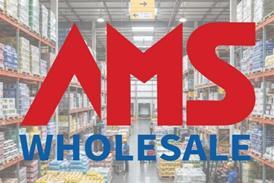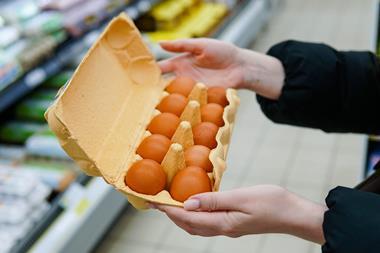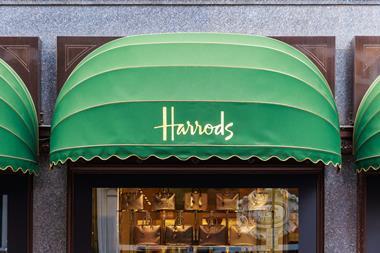The hot topic at the CIES Food Business Forum in Barcelona was how to improve RFID tagging technology, says Beth Brooks
The theme may have been Creating Tomorrow’s Supply Chain, but at the CIES Food Business Forum supply chain conference in Barcelona last week the hottest debate was about how to improve today’s supply chain and, more specifically, the readability of RFID tags.
More than 260 delegates from 31 countries gathered to hear the latest thinking from a host of big names in the logistics arena, including Ian Mumby, head of supply chain, logistics and IT for Marks & Spencer’s food division, Lawrence Christensen, supply chain director for Sainsbury, and Frank Körber, chief operating officer, Europe, for German retailer Metro Group Logistics.
Despite the push into RFID by a number of major grocery retailers, including Wal-Mart and Tesco, a number of delegates echoed the concerns over tag readability expressed earlier in the year by Tesco group technology director John Clarke.
However, the UK retailers speaking at the conference claimed that they had ironed out most of the problems. Mumby told delegates that “far from being a trial, RFID is now a reality at Marks & Spencer”.
He argued that the problem was not so much in the readability of RFID tags but in their write-ability - how successfully suppliers were writing data on to the tags so that they could be accurately read by M&S. Since M&S trialled RFID in 2001-2002, it has increased the number of tags it is reading to one million a week in its six distribution centres, he said, claiming that the retailer’s read-ability rates were approaching 100% and posed no problem - even when the tags were wrapped in aluminum foil, frozen in liquid nitrogen, boiled at high temperatures or washed 500 times.
Up to 105 suppliers are currently providing information for the tags at M&S’s six depots and Mumby said that one of its suppliers - food manufacturer RF Brookes - had achieved a read rate of 99.98%. “One day we will get to the point where the tag is king and it will be more important than barcodes,” he said. This was already the case at its depot in Barnsley, South Yorkshire, where 70% of products are tagged, and it had estimated that the rest of its depots should reach this level within six months, he said.
Sainsbury’s Christensen reiterated the comments he made in The Grocer last week, telling delegates how he was reinventing the supermarket group’s supply chain in the effort to “Make Sainsbury’s Great Again” and was considering the possibility of introducing RFID next year. He added that changes so far had not only reduced out of stocks by 75%, but had also created a “retail-centric culture” and boosted staff morale.
Despite these success stories, it is clear that RFID problems still persist for some. A delegate from Belgian retailer Delhaize Group protested that although his company was working on tests to roll out RFID, the pilot trial had been hampered because the group had managed to achieve a read rate for cases of only 80%. A representative from French hypermarket chain Auchan added that it had managed to achieve an efficient supply chain without the use of RIFID.
Manufacturers also expressed their reservations. Antonia Wanner, head of purchasing for Nestlé Germany, said that Nestlé has been running an RFID pilot on pallets with German retailer Metro since November 2004, advancing to RFID on cases earlier this year. During this time, Wanner said that getting the technology to work had been the biggest problem because Nestlé had to work out how to gather all the necessary data. She reported that its forklift truck drivers were driving through RFID gates - similar to airport security gates - too quickly to catch the data.
However, instead of imposing speed limits on its drivers, Nestlé had created so-called ‘flag tags’ with powerful antennas that stick out of the pallets so that the data can be read properly. The tags, Wanner said, were tested extensively in real environments and remained 100% effective. The group was now searching for a solution to read RFID on cases. “This illustrates the fact that complete technical solutions do not exist; you have to do a lot of technical development yourself.”
RFID was not the only topic for discussion at the conference, with global retailers Carrefour and Metro revealing how changes made to their supply chains had led to much smoother operations.
Xavier Hua, group suppliers interface for French retailer Carrefour, described how slick the supply chain was throughout its operations in France, China and Poland. Within the past year, the group has moved from a logistical strategy to a supply chain strategy that uses pooling and consolidation to increase shelf availability. In France, the group has introduced a programme called VMI pooling, where suppliers combine deliveries from a shared distribution centre to a Carrefour regional distribution centre. The programme has resulted in a 20% fall in stock levels at the distribution centre and an increase in full-truck rates from 79% to 98%.
Supply chain optimisation was also working well in emerging markets, he said. In Poland, where the group has introduced a three-to-one pooling system, truck-filling rates have increased from 50% to 85%.
Its Chinese operations have also benefited from a change in supply chain, with the group introducing consolidation centres for own-label products in response to in-store product shortages of 10%. This resulted in a fall in stock levels from 55 days to fewer than 20 days and a 100% on-time delivery rate to stores.
And, expecting nothing less from the ultra-efficient Germans, Körber gave delegates an insight into the well-oiled machine of Metro Group Logistics, where the group is slowly linking up its international operations to its main operations in Berlin, Germany. The retailer has already connected Austria and Poland to its German hub, with on-time delivery times to store of 98%. “By on-time, I mean the time the store expects delivery and the time that the supplier has to be at the first truck. It is strictly on time,” he said.
It also operates MGL in countries such as Turkey, Russia, Belgium, the Netherlands, Greece, the Czech Republic and Hungary, and later this month will expand into the Ukraine. Launches in Romania, Italy, Spain, Croatia and Bosnia are expected in 2006.
Many speakers echoed the view that simplicity is vital to success. Jonathan Pearce, head of supply chain management for Nestlé Europe, said simplicity could solve 80% of the problems faced by managers and directors. “Personally, I don’t think we need to focus on reinventing new solutions to problems. We need to simplify what we can and create value for our business and consumers,” he said.
Supply chain ethos
>>A lesson from Wal-mart canada
Just two weeks into the job, Asda’s new chief operating officer, David Cheesewright, changed his schedule last minute to share with delegates a comparison between Wal-Mart Canada, where he has just completed a year in the same job, and Asda.
Highlighting the differences, he pointed out that Wal-Mart Canada operates 261 stores to Asda’s 291, while the average Asda store has twice the turnover of a Wal-Mart Canada store, which is more of a general retailer. Priorities were also different when it came to layout, he said: “The fundamental difference between food retailers and general merchandisers is that food buyers do not have to worry about layout. GM retailers are more interested in loyalty and pulling customers into every corner of the store.”
But both retailers were striving for best practice in their own ways, he said. “Asda’s is very much its use of space, its friendly stores and central ordering system, whereas Wal-Mart Canada’s is ownership, pragmatism and consistency.”
The theme may have been Creating Tomorrow’s Supply Chain, but at the CIES Food Business Forum supply chain conference in Barcelona last week the hottest debate was about how to improve today’s supply chain and, more specifically, the readability of RFID tags.
More than 260 delegates from 31 countries gathered to hear the latest thinking from a host of big names in the logistics arena, including Ian Mumby, head of supply chain, logistics and IT for Marks & Spencer’s food division, Lawrence Christensen, supply chain director for Sainsbury, and Frank Körber, chief operating officer, Europe, for German retailer Metro Group Logistics.
Despite the push into RFID by a number of major grocery retailers, including Wal-Mart and Tesco, a number of delegates echoed the concerns over tag readability expressed earlier in the year by Tesco group technology director John Clarke.
However, the UK retailers speaking at the conference claimed that they had ironed out most of the problems. Mumby told delegates that “far from being a trial, RFID is now a reality at Marks & Spencer”.
He argued that the problem was not so much in the readability of RFID tags but in their write-ability - how successfully suppliers were writing data on to the tags so that they could be accurately read by M&S. Since M&S trialled RFID in 2001-2002, it has increased the number of tags it is reading to one million a week in its six distribution centres, he said, claiming that the retailer’s read-ability rates were approaching 100% and posed no problem - even when the tags were wrapped in aluminum foil, frozen in liquid nitrogen, boiled at high temperatures or washed 500 times.
Up to 105 suppliers are currently providing information for the tags at M&S’s six depots and Mumby said that one of its suppliers - food manufacturer RF Brookes - had achieved a read rate of 99.98%. “One day we will get to the point where the tag is king and it will be more important than barcodes,” he said. This was already the case at its depot in Barnsley, South Yorkshire, where 70% of products are tagged, and it had estimated that the rest of its depots should reach this level within six months, he said.
Sainsbury’s Christensen reiterated the comments he made in The Grocer last week, telling delegates how he was reinventing the supermarket group’s supply chain in the effort to “Make Sainsbury’s Great Again” and was considering the possibility of introducing RFID next year. He added that changes so far had not only reduced out of stocks by 75%, but had also created a “retail-centric culture” and boosted staff morale.
Despite these success stories, it is clear that RFID problems still persist for some. A delegate from Belgian retailer Delhaize Group protested that although his company was working on tests to roll out RFID, the pilot trial had been hampered because the group had managed to achieve a read rate for cases of only 80%. A representative from French hypermarket chain Auchan added that it had managed to achieve an efficient supply chain without the use of RIFID.
Manufacturers also expressed their reservations. Antonia Wanner, head of purchasing for Nestlé Germany, said that Nestlé has been running an RFID pilot on pallets with German retailer Metro since November 2004, advancing to RFID on cases earlier this year. During this time, Wanner said that getting the technology to work had been the biggest problem because Nestlé had to work out how to gather all the necessary data. She reported that its forklift truck drivers were driving through RFID gates - similar to airport security gates - too quickly to catch the data.
However, instead of imposing speed limits on its drivers, Nestlé had created so-called ‘flag tags’ with powerful antennas that stick out of the pallets so that the data can be read properly. The tags, Wanner said, were tested extensively in real environments and remained 100% effective. The group was now searching for a solution to read RFID on cases. “This illustrates the fact that complete technical solutions do not exist; you have to do a lot of technical development yourself.”
RFID was not the only topic for discussion at the conference, with global retailers Carrefour and Metro revealing how changes made to their supply chains had led to much smoother operations.
Xavier Hua, group suppliers interface for French retailer Carrefour, described how slick the supply chain was throughout its operations in France, China and Poland. Within the past year, the group has moved from a logistical strategy to a supply chain strategy that uses pooling and consolidation to increase shelf availability. In France, the group has introduced a programme called VMI pooling, where suppliers combine deliveries from a shared distribution centre to a Carrefour regional distribution centre. The programme has resulted in a 20% fall in stock levels at the distribution centre and an increase in full-truck rates from 79% to 98%.
Supply chain optimisation was also working well in emerging markets, he said. In Poland, where the group has introduced a three-to-one pooling system, truck-filling rates have increased from 50% to 85%.
Its Chinese operations have also benefited from a change in supply chain, with the group introducing consolidation centres for own-label products in response to in-store product shortages of 10%. This resulted in a fall in stock levels from 55 days to fewer than 20 days and a 100% on-time delivery rate to stores.
And, expecting nothing less from the ultra-efficient Germans, Körber gave delegates an insight into the well-oiled machine of Metro Group Logistics, where the group is slowly linking up its international operations to its main operations in Berlin, Germany. The retailer has already connected Austria and Poland to its German hub, with on-time delivery times to store of 98%. “By on-time, I mean the time the store expects delivery and the time that the supplier has to be at the first truck. It is strictly on time,” he said.
It also operates MGL in countries such as Turkey, Russia, Belgium, the Netherlands, Greece, the Czech Republic and Hungary, and later this month will expand into the Ukraine. Launches in Romania, Italy, Spain, Croatia and Bosnia are expected in 2006.
Many speakers echoed the view that simplicity is vital to success. Jonathan Pearce, head of supply chain management for Nestlé Europe, said simplicity could solve 80% of the problems faced by managers and directors. “Personally, I don’t think we need to focus on reinventing new solutions to problems. We need to simplify what we can and create value for our business and consumers,” he said.
Supply chain ethos
>>A lesson from Wal-mart canada
Just two weeks into the job, Asda’s new chief operating officer, David Cheesewright, changed his schedule last minute to share with delegates a comparison between Wal-Mart Canada, where he has just completed a year in the same job, and Asda.
Highlighting the differences, he pointed out that Wal-Mart Canada operates 261 stores to Asda’s 291, while the average Asda store has twice the turnover of a Wal-Mart Canada store, which is more of a general retailer. Priorities were also different when it came to layout, he said: “The fundamental difference between food retailers and general merchandisers is that food buyers do not have to worry about layout. GM retailers are more interested in loyalty and pulling customers into every corner of the store.”
But both retailers were striving for best practice in their own ways, he said. “Asda’s is very much its use of space, its friendly stores and central ordering system, whereas Wal-Mart Canada’s is ownership, pragmatism and consistency.”















No comments yet